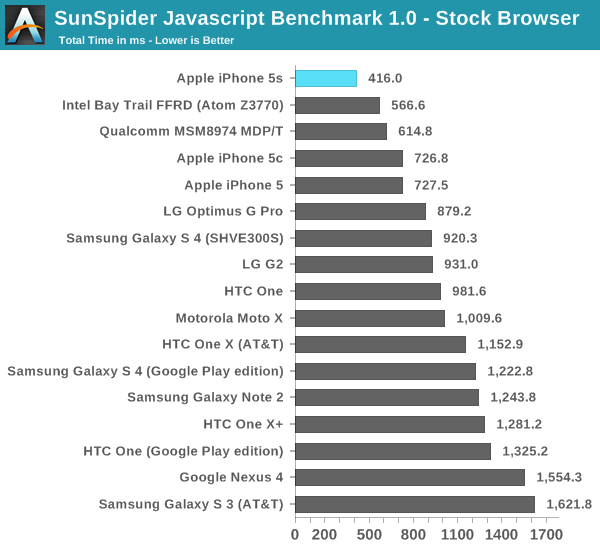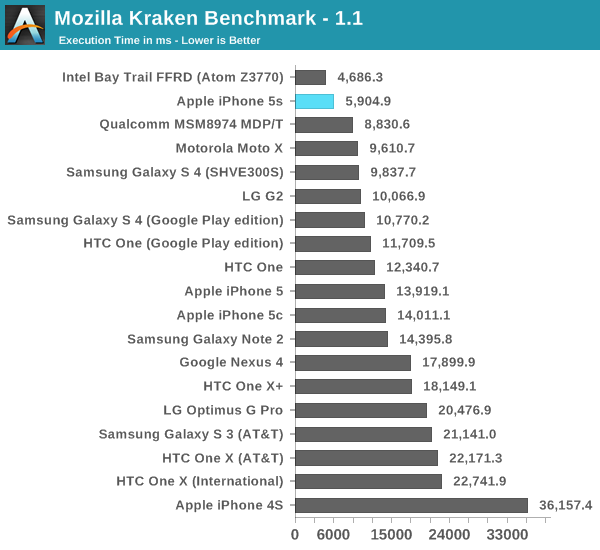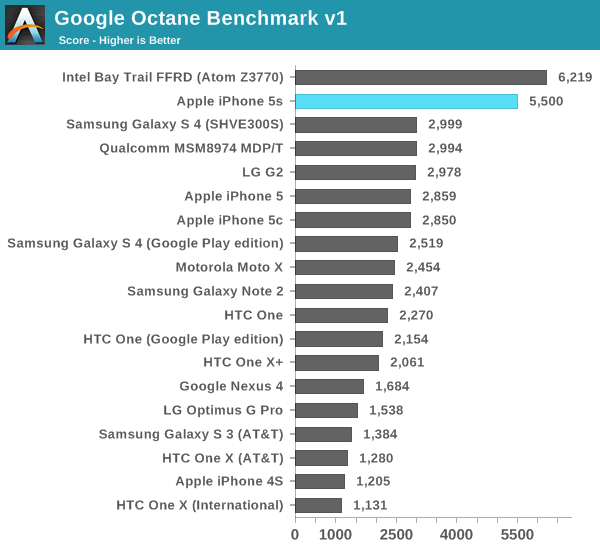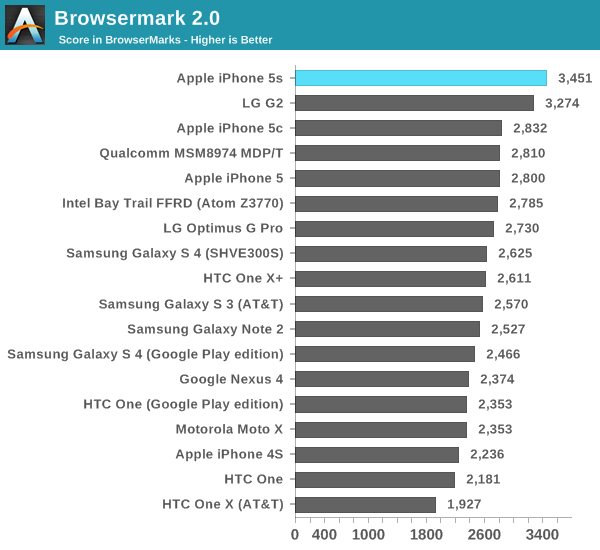The iPhone 5s Review
by Anand Lal Shimpi on September 17, 2013 9:01 PM EST- Posted in
- Smartphones
- Apple
- Mobile
- iPhone
- iPhone 5S
CPU Performance
For our cross-platform CPU performance tests we turn to the usual collection of Javascript and HTML5 based browser tests. Most of our comparison targets here are smartphones with two exceptions: Intel's Bay Trail FFRD and Qualcomm's MSM8974 Snapdragon 800 MDP/T. Both of those platforms are test tablets, leveraging higher TDP silicon in a tablet form factor. The gap between the TDP of Apple's A7 and those two SoCs isn't huge, but there is a gap. I only include those platforms as a reference point. As you're about to see, the work that Apple has put into the A7 makes the iPhone 5s performance competitive with both. In many cases the A7 delivers better performance than one or both of them. A truly competitive A7 here also gives an early indication of the baseline to expect from the next-generation iPad.
We start with SunSpider's latest iteration, measuring the performance of the browser's js engine as well as the underlying hardware. It's possible to get good performance gains by exploiting advantages in both hardware and software here. As of late SunSpider has turned into a bit of a serious optimization target for all browser and hardware vendors, but it can be a good measure of an improving memory subsystem assuming the software doesn't get in the way of the hardware.

Bay Trail's performance crown lasted all of a week, and even less than that if you count when we actually ran this benchmark. The dual-core A7 is now the fastest SoC we've tested under SunSpider, even outpacing Qualcomm's Snapdragon 800 and ARM's Cortex A15. Apple doesn't quite hit the 2x increase in CPU performance here, but it's very close at a 75% perf increase compared to the iPhone 5. Update: Intel responded with a Bay Trail run under IE11, which comes in at 329.6 ms.
Next up is Kraken, a heavier js benchmark designed to stress more forward looking algorithms. Once again we run the risk of the benchmark becoming an optimization target, but in the case of Kraken I haven't seen too much attention paid to it. I hope it continues to fly under the radar as I've liked it as a benchmark thus far.

The A7 falls second only to Intel's Atom Z3770. Although I haven't yet published these results, the 5s performs very similarly to an Atom Z3740 - a more modestly clocked Bay Trail SKU from Intel. Given the relatively low CPU frequency I'm not at all surprised that the A7 can't compete with the fastest Bay Trail but instead is better matched for a middle of the road SKU. Either way, A7's performance here is downright amazing. Once again there's a performance advantage over Snapdragon 800 and Cortex A15, both running at much higher peak frequencies (and likely higher power levels too, although that's speculation until we can tear down an S800 platform and a 5s to compare).
Compared to the iPhone 5, the 5s shows up at over 2.3x the speed of last year's flagship.
Next up is Google's Octane benchmark, yet another js test but this time really used as a design target for Google's own V8 js engine. Devices that can run Chrome tend to do the best here, potentially putting the 5s at a disadvantage.

Bay Trail takes the lead here once again, but again I expect the Z3740 to be a closer match for the A7 in the 5s at least (it remains to be seen how high the iPad 5 version of Cyclone will be clocked). The performance advantage over the iPhone 5 is a staggering 92%, and obviously there are big gains over all of the competing ARM based CPU architectures. Apple is benefitting slightly from Mobile Safari being a 64-bit binary, however I don't know if it's actually getting any benefit other than access to increased register space.
Our final browser test is arguably the most interesting. Rather than focusing on js code snippets, Browsermark 2.0 attempts to be a more holistic browser benchmark. The result is much less peaky performance and a better view at the sort of moderate gains you'd see in actual usage.

There's a fair amount of clustering around 2500 with very little differentiation between a lot of the devices. The unique standouts are the Snapdragon 800 based G2 from LG, and of course the iPhone 5s. Here we see the most modest example of the A7's performance superiority at roughly 25% better than the iPhone 5. Not to understate the performance of the iPhone 5s, but depending on workload you'll see a wide range of performance improvements.










464 Comments
View All Comments
rchangek - Wednesday, September 18, 2013 - link
They are releasing A1528 in China for China Unicom and I find it weird that it is not listed anywhere in the LTE support documentation.jasonelmore - Wednesday, September 18, 2013 - link
Great review, 1st on the web to my knowledge. However there are a few points i want to note.1: Brian is your mobile guy, He knows a lot more than anand on this front. When i saw anand did this review, i cant help but think some fanboyism is taking place here, which could hinder credibility.
2: You say the iphone 5S GPU is more powerful than the GPU in the iPad 4 but looking at the charts, its on par/same as the ipad 4. A achivement none-the-less, but the results are well within the margin of error (1fps)
doobydoo - Wednesday, September 18, 2013 - link
I don't think there are any question marks over Anands credibility and it's a little silly to make out that there are.jasonelmore - Wednesday, September 18, 2013 - link
i'm just sayin, it makes me wonder if he's being 100% objective. and if i wonder it, then others will to. Bryan is a mobile author who reviews every mobile device to come through the labs, but when apple phones come out, suddenly anand takes the reigns from him. It's not like there are a ton of different phones out right now and they needed to spread the workload, anand could've at least let bryan do the 5C review, but nah, he wanted both.Mondozai - Wednesday, September 18, 2013 - link
I remember Anand saying that Brian would get the iPhone 5s review, but apparently that changed.In my opinion, this is for the better. Anand knows more about CPU's and GPU's than Brian and the most significant change with the iPhone 5s was the A7 chip, together with the camera.
And, as you'll recall, Brian did a piece already on the 5s camera and cameras are sort of his speciality on smartphones, together with wireless.
Secondly, and I'm just speculating here, Brian is known as more of an Android guy. Could it be that he is already working on another review, like the Z1 or the Note 3? He can't do them all.
dugbug - Wednesday, September 18, 2013 - link
That changed IMHO with the 64-bit CPU. Not sure why anand doing the review matters to you, but the guy is amazing with CPU and GPU analysis. Let Bryan do follow-up analysis.repoman27 - Wednesday, September 18, 2013 - link
The embargo was lifted only one week after the reviewers got their hands on the devices, that's why Anand did these phones and not Brian. Regardless, Brian would have likely needed Anand to contribute on the A7 analysis, which was a crucial component of this review, and we would all still be waiting for a thesis from Brian.susan_wong - Wednesday, September 18, 2013 - link
For the AT Smartphone Bench battery life test:It would be great to know how many total web pages were loaded for each of the 4S, 5 and 5S before the battery died.
Krysto - Wednesday, September 18, 2013 - link
Seems like Apple got to 64-bit first only because they didn't redesign the CPU core, too, like everyone else is doing. They rebuilt Swift on top of ARMv8 and just tweaked it.ltcommanderdata - Wednesday, September 18, 2013 - link
http://www.anandtech.com/show/6420/arms-cortex-a57..."Architecturally, the Cortex A57 is much like a tweaked Cortex A15 with 64-bit support."
"Similarly, the Cortex A53 is a tweaked version of the Cortex A7 with 64-bit support."
The 64-bit Cortex A57 and Cortex A53 are directly based on the existing 32-bit A15 and A7 respectively. That Apple's Cyclone is based on Swift really isn't a reason to dismiss it especially given how effective the results are.